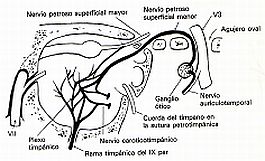 Nervus tympanicus: tiene su origen en el n. glosofaríngeo. Está formado por un tronco principal que puede ser único, alcanzando el promontorio a través de un fino canal que cruza entre el golfo de la yugular y el canal carotídeo. En el otro extremo de este canal se encuentra el ganglio geniculado, desde donde continua con el nervio petroso superficial mayor. Envía fibras parasimpáticas para la glándula parótida. Se distribuye por el promontorio mediante seis ramas terminales: dos ramas posteriores para la ventana oval y redonda, dos superiores para los nervios petrosos profundos y dos ramas anteriores que son la carótido-timpánica y la tubárica. Es sensitivo y parasimpático. Da tres ramas: Ramo para la ventana oval, Ramo para la ventana redonda, Ramo tubárico, Ramo caroticotimpánico, Nervio petroso profundo mayor, Nervio petroso superficial menor.
Nervus tympanicus: tiene su origen en el n. glosofaríngeo. Está formado por un tronco principal que puede ser único, alcanzando el promontorio a través de un fino canal que cruza entre el golfo de la yugular y el canal carotídeo. En el otro extremo de este canal se encuentra el ganglio geniculado, desde donde continua con el nervio petroso superficial mayor. Envía fibras parasimpáticas para la glándula parótida. Se distribuye por el promontorio mediante seis ramas terminales: dos ramas posteriores para la ventana oval y redonda, dos superiores para los nervios petrosos profundos y dos ramas anteriores que son la carótido-timpánica y la tubárica. Es sensitivo y parasimpático. Da tres ramas: Ramo para la ventana oval, Ramo para la ventana redonda, Ramo tubárico, Ramo caroticotimpánico, Nervio petroso profundo mayor, Nervio petroso superficial menor. Sinónimo: nervio timpánico.
<(A): Nervus Jacobson; Nervus tympanicus: Dieser Nerv löst sich vom Nervus glossus-pharyngeus am seitlichen Rand des Ganglion inferior des Nervus glossus-pharyngeus, verläuft entlang des Kammes, der die Fossa jugularis vom Foramen carotis trennt, tritt in den Canaliculus tympanicus ein und gelangt in die Paukenhöhle.
<(F): Nerf du Jacobson; nerf tympanique: ce nerf se détache du nerf glosso-pharyngien au bord latéral du ganglion inférieur du nerf glosso-pharyngien, longe la crête qui sépare la fosse jugulaire du foramen carotidien, pénètre dans le canalicule tympanique et arrive dans la caisse du tympan.
<(Ing): Jacobson's nerve, tympanic nerve: tympanic branch of glossofparingeal nerve. It arises from the petrous ganglion, and ascends to the tympanic cavity through a small canal, the fossula petrosa/Tympanic canaliculi, on the under surface of the petrous portion of the temporal bone on the ridge which separates the carotid canal from the jugular fossa. In the tympanic cavity it divides into branches which form the tympanic plexus and are contained in grooves upon the surface of the promontory. It is mainly sensory to the tympanic cavity but there are a few secretomotor fibers from the inferior salivatory nucleus. They will pass straight through the tympanic plexus in order to reach the otic ganglion through the lesser petrosal nerve. Their postganglionic fibers reach the parotid gland. Branches: preganglionic fibers to the otic ganglion and branches to the tympanic plexus. Functional components: GSA fibers, which are for somatic sensation; GVE fibers, which pass through to the otic ganglion from the inferior salivatory nucleus. Root: the sensory component of the nerve have their roots in the spinal tract and nucleus of V (general sensation) and the nucleus of tractus solitarius (taste).
ANATOMÍA:
- ANATOMY OF THE HUMAN BODY. <(Ing)
FUENTES DE INFORMACIÓN BIOMÉDICA:
- GOOGLE ACADEMICO. <(E)
- GOOGLE SCHOLAR. <(Ing)
- NCBI: Entrez. <(Ing)
- PubMed. <(Ing)
TÉRMINOS RELACIONADOS:
